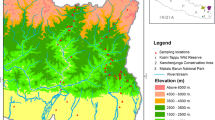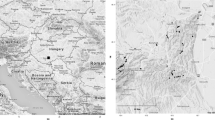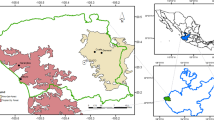Abstract
In order to study the relationship between community organization and spatial-temporal variability, species richness and abundance of amphibian species were estimated in 17 sites of the French Upper Rhone floodplain. These sites were chosen because they were representative of the diversity of successional processes, age and connection with the active channel. Ecological variation among these sites was estimated by the analysis of 14 mesological, hydrological, and biotic variables, by means of correspondence analysis. Level of disturbance, eutrophication, water origin, presence of fish and water persistence were the main determinants of site typology.
Amphibian species richness was highest in temporary sites experiencing intermediate level of disturbance. Three species (Rana ridibunda, Rana dalmatina, Triturus helveticus) were ubiquitous three species (Hyla arborea, Bufo calamita, Pelodytes punctatus) were characteristic of habitats with intermediate variability and four (Triturus cristatus, Triturus alpestris, Bufo bufo, Bombina variegata) were rare in the floodplain. The most abundant species in the floodplain appeared to be r-selected and most of them showed a temporal flexibility of reproduction. These reproduction traits were assumed to respond to the balance between habitat unpredictability and interspecific constraint by making the adjustment to both availability and suitability of breeding habitats possible.
Similar content being viewed by others
References
Beebee, T. J. C., 1985. Discriminant analysis of amphibian habitat determinants in South-East England. Amphibia-Reptilia 6: 35–43.
Bravard, J. P., C. Amoros & G. Pautou, 1986. Impact of civil engineering works on the successions of communities in a fluvial system. Oikos 47: 92–111.
Bregulla, D., 1988. Die Pfütze als Kleinlebensraumüberlebensrategie einer bemerkenswerten einheimischen kröte. PdB-B. 4: 37–38.
Castanet, J. & R. Guyetant, 1989. Atlas de répartition des amphibiens et reptiles de France. Société Herpétologique de France, Paris, 191 pp.
Chessel, D. & S. Doledec, 1992. ADE Version 3.4. Multivariate analysis and graphical display for environmental data. Université Lyon-I. Documentation, 30 pp.
Diaz-Paniagua, C., 1988. Temporal segragation in larval amphibian communities in temporary ponds at a locality in SW Spain. Amphibia-Reptilia 9: 12–26.
Dolmen, D. 1988. Coexistence and niche segragation in the newts Triturus vulgaris (L.) and Triturus cristatus (L.). Amphibia-Reptilia 9: 365–374.
Grossenbacher, K., 1988. Atlas de distribution des amphibiens de Suisse. Rapport L.S.P.N., Bâle, 208 pp.
Joly, P., 1992. The amphibia fauna of the Upper-Rhone floodplain. The Lavours marsh and the Jons sector. Alytes 10: 117–129.
Knoepffler, L. P., 1962. Contribution à l'étude du genre Discoglossus (amphibiens, anoures). Vie Milieu 13: 1–95.
Lamotte, M. & J. Lescure, 1977. Tendances adaptatives à l'affrachissement du milieu aquatique chez les amphibiens anoures. Terre Vie 30: 225–312.
MacArthur, R. H. & E. O. Wilson, 1967. The theory of island biogeography. In Princeton, N.J., Princeton University Press, 203 pp.
Oldham, R. S. & M. J. S. Swan, 1991. Conservation of amphibian populations in Britain. In A. Seitz & V. Loeschcke, Species conservation: a population-biological approach, Basel: 141–157.
Pavignano, I., C. Giacoma & S. Castellano, 1990. A multivariate analysis of amphibian habitat determinants in north western Italy. Amphibian-Reptilia 11: 311–324.
Pianka, E. R., 1970. On r- and K- selection. Am. Nat. 104: 592–597.
Richardot-Coulet, M., E. Castella & C. Castella, 1987. Classification and succession of former channels of the French Upper Rhône alluvial plain using Mollusca. Regulated Rivers 1: 111–127.
Rostan, J. C., C. Amoros & J. Juget, 1987. The organic content of the surficial sediment: a method for the study of ecosystems development in abandoned channels. Hydrobiologia 148: 45–62.
Salthe,. N., 1969. Reproductive modes and the number and sizes of ova in the urodeles. Am. Midl. Nat. 81: 467–490.
Salthe, S. N. & W. E. Duellman, 1973. Quantitative constraint associated with reproductive mode in anurans. In J. L. Vial (ed.), Evolutionary Biology of the anurans: contemporary Research on Major Problems. University Missouri Press, Columbia: 229–249.
Trivers, R. L., 1972. Parental investment and sexual selection. In B. G. Campbell (ed.), Sexual selection and the Descent of Man. Aldine Press, Chicago: 136–179.
Tester, U., 1990. Artenschützerisch relevante Aspekte zur Ökologie des Laubfroschs (Hyla arborea L.). Thése de doctorat, Basel, 291 pp.
Woodward, B. D., 1982. Local intraspecific variation in clutch parameters in the spotted salamander (Ambystoma maculatum). Copeia 1: 157–160.
Author information
Authors and Affiliations
Rights and permissions
About this article
Cite this article
Morand, A., Pierre, J. Habitat variability and space utilization by the amphibian communities of the French upper-rhone floodplain. Hydrobiologia 300, 249–257 (1995). https://doi.org/10.1007/BF00024465
Issue Date:
DOI: https://doi.org/10.1007/BF00024465




